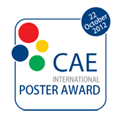
| |
EnginSoft - CAE Conference Abstracts
EnginSoft International Conference 2011 |
Patient Specific CFD Models of the Aortic Arch: on the Relevance of Imposing Spatialvelocity Profile vs Flow Rate Boundary Conditions in Hemodynamics
|
Ponzini Raffaele - CILEA (Italy) |
Abstract |
So-called patient specific CFD models are build tanks to in vivo imaging techniques that allow to obtain accurate 3D virtual models of the anatomy under consideration. In most advanced CFD hemodynamics models the anatomical model is fulfilled with Dirichlet-like boundary conditions (BC) at the inlet/outlet as flow-rate waveforms using a-priori imposed flow-split distribution or using more sophisticated dynamic coupled models (0-D networks) of the downstream circulation. Nevertheless in all cases simplified spatial velocity profiles are assumed at the boundaries regardless to the effect of eventual secondary motion on the overall computed flow field. This choice is taken due to intrinsic lack of knowledge on the effective velocity distribution at the section of interest. Today phase contrast MRI (PCMRI) allows to measure point wise the 3D velocity vector field (including therefore eventual secondary swirling components) and these data are suitable to be imposed as realistic patient specific boundary conditions. In this work we evaluate the effect of imposing flow rate BC or measured point-wise velocity BC on a patient specific aortic arch model aiming at analyze if and eventually how simplified BC setups can affect the evaluation of meaningful wall-related indicators. Material and Methods: A patient specific dataset (anatomy and BC) is obtained by processing 4D PCMRI data (3D in space over time). Using these data we build two identical models of aortic arch differing only for the ascending aorta section (inlet) where we set: (i) MR measured point wise 3D vector field; (ii) MR measured flow-rate (equivalent to (i) but with a simplified spatial velocity profile where no secondary flow is present). Blood has been modeled as an unsteady Newtonian incompressible fluid in a about 6 million cells fluid domain (tetrahedral mesh elements). Wall has been modeled as rigid boundaries and no-slip condition has been applied. Boundary condition at the four outlets (descending aorta and supra-aortic branches) has been implemented using stress free condition in order to selectively measure the effect of inlet BC setup alone. The flow rate distribution in the four outlet sections, streamlines flow patterns and wall shear stress distribution. Steady and unsteady simulations has been performed using Ansys Fluent as Navier-Stokes solver. Results: Relevant differences on the studied quantities has been qualitatively observed and quantitatively measured comparing the two models outputs suggesting that in the future in order to build patient specific models a more care need to be paid on the implementation measure spatial velocity distribution at the boundary sections. More studies are ongoing to establish to which extent these preliminary results can be generalized. |
Back to index |



